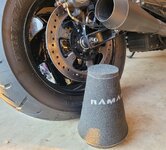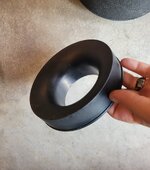Claviger
Aspiring Student
- Joined
- Jul 25, 2014
- Messages
- 6,934
- Location
- Olympia Washington
- Ride
- '21 Z H2, '14 R3R, '02 Daytona 955i
Not running the V-stacks at the moment, using K&N 4040s. I have to come up with a salt friendly intake, something I can safety wire to the bike and be positive will stay in place at max speed while gaining ~4"+ of length and pulling clean air.
It might be me being fussy, but in short, no. I was not satisfied with the tune on Mufasa or Alice. Both bikes had issues in the sub 25% throttle range after my visits there, above that was fine. Alice was easy to correct thanks to Woolich and the more advanced ECU.
It's fine though, the most difficult areas to calibrate on the street are accurate on both bikes.
The Rocket is a bit of a PITA to tune below 3% throttle, mainly because of bored out TBs and low vacuum (relative to stock R3) from big cams. I don't know that it's reasonable to expect perfect fueling in that area from dyno time alone due to the differences in the way the engine is loaded there.
It might be me being fussy, but in short, no. I was not satisfied with the tune on Mufasa or Alice. Both bikes had issues in the sub 25% throttle range after my visits there, above that was fine. Alice was easy to correct thanks to Woolich and the more advanced ECU.
It's fine though, the most difficult areas to calibrate on the street are accurate on both bikes.
The Rocket is a bit of a PITA to tune below 3% throttle, mainly because of bored out TBs and low vacuum (relative to stock R3) from big cams. I don't know that it's reasonable to expect perfect fueling in that area from dyno time alone due to the differences in the way the engine is loaded there.


